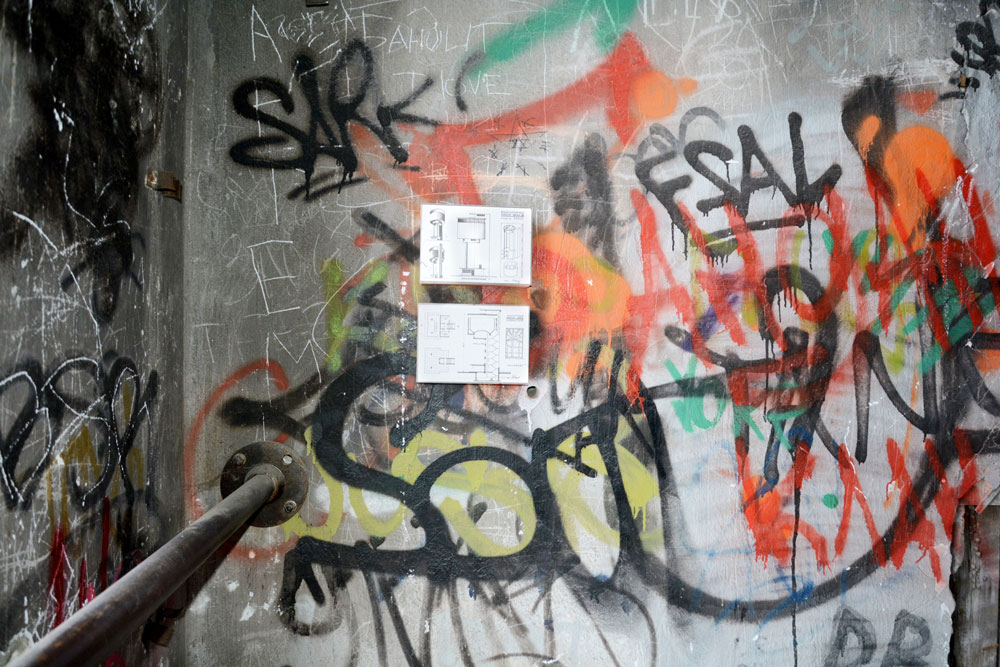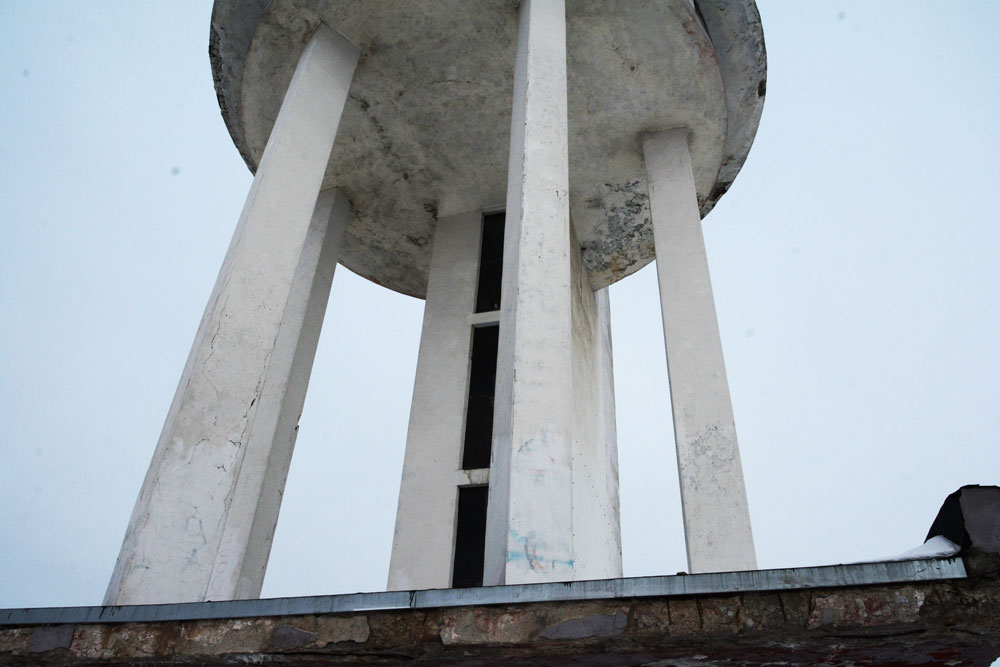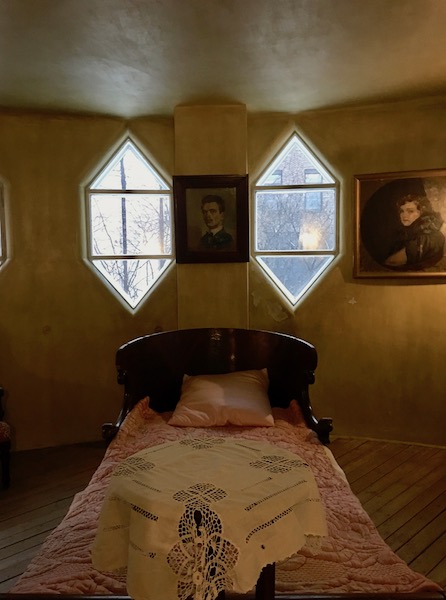Bitterly cold, stark uncompromising weather was the perfect backdrop to my visit to Yekaterinburg in Russia to photograph an iconic landmark, the beautiful Constructivist White Tower built in 1931 by Moisei Reischer.

As I put on my double layer of socks, double layer of trousers and Canadian winter boots capable of crushing any opposition on the London Tube in seconds, I mused that it was a shame the snow-boots weigh a ton or I’d pop them on every morning just to stampede my way to a seat. I’d been told to wrap up for my visit to the White Tower, it was already minus 12 degrees outside …in typical Russian style, indoors a tropical 78 degrees, whipping layers of clothing on and off had become an art-form.

My guide and archi-hero was Evgeny Volkov, a key member of the Podelniki Architectural Group and a driving force in the White Tower Project. One of its missions is to protect what was, in its day, the world’s largest water tower and is today an iconic structure admired worldwide. Podelniki wants to ensure that the White Tower continues to be sympathetically restored, brought back to life properly understood and protected for future generations.

Evgeny Volkov, Polina Ivanova and Antonina Savilova studied architecture together and formed Podelniki as a club, the name translates as partners in crime. Their raison d’etre was and remains to promote the development of architecture, history, culture and art – they’re now professional architects and their club has morphed into an association has gone from strength to strength. What’s so refreshing is that they are determined not to be a closed clique, they want as many people as possible to engage and enjoy their projects Early in their careers they recognized how important Yekaterinburg’s Constructivist architecture was, and as students held the city’s first online Architecture Day celebrating Russian architecture.
The White Tower wasn’t the only formerly loved building on their radar in Russia’s fourth largest City and industrial heartland, but it was iconic. When a vacuum occurred when the Red Cross vacated the building in 2006 a real risk arose. With no maintenance programme in place and no protection by 2012, local reports suggested it was in danger of being pulled down, which would have been tragic. The ‘partners in crime’ stepped in to save the unique monument of constructivist architecture. Determined and with an understanding of how to apply to get a protected status, Podelniki successfully registered their fledgeling organization to manage the tower. Of course, there can be a gap between aspiration and reality as the magnitude of the task unfolded. Working together with the Editor of Tatlin publishing house, a local lawyer and the Uralmash museum they contacted the architect’s family. Luckily they still had Moisei Reischer’s archive. It turned out that as recently as 1971, Reischer had hoped to convert his beloved water tower into a café with a birds-eye view of the city. What a cracking idea, but having headed up and down the internal staircases it was hard to imagine how that goal could be achieved
The Podelniki team called in all their favours from friends and family and focused on a hardcore clean-up of the interior and exterior, stripping back the years of neglect. The tower was returned to white, graffiti is still in evidence in the interior, purposefully, as a reminder, it really does add something atmospherically. It is now back connected to the city electricity grid, no mean feat. The task ahead is to fully ensure that the monument is properly listed and to grow the project which means raising a significant amount of money to complete the restoration.

Why visit Yekaterinburg? If you love modernism, 3-dimensional cubism, brutalism and you want to put the jigsaw pieces together, this is a rare treat to experience large-scale constructivist architecture in a city which is home to more than 140 buildings. Curiously the winter weather enhances the experience…it’s a version of keeping it real with a side order of frostbite. If you imagine Moscow and St Petersburg as the heart and soul of the country, the Urals and Yekaterinburg are the guts and belly.

For nearly 70 years the city of Sverdlovsk, as Yekaterinburg was known from 1924 to 1991, had a touch of amnesia forgetting that it was named in honour of Yekaterina, the wife of Tsar Peter the Great. It was the birthplace of President Boris Yeltsin, the place where Gary Power’s spy plane got shot down in 1960–thank you, Tom Hanks, in Bridge of Spies, and where Nikolai Aleksandrovich Romanov the former Tsar and his family were imprisoned after the 1917 revolution, shot and buried.

The region is not without complications, steeped in the history of industrialization and politicization in Russia. Sitting on the border of Europe and Asia, Yekaterinburg it is just two hour’s drive from Ozersk, sometimes known as City40, a closed city deep in the forest of the Ural Mountains.
To consider what was at the heart of the Constructivist movement one should return to when the dial was reset in Russia. The royal family gone, a new era was emerging and the Constructivist movement was in the front line, translating this new world through design, seeking ways to bring the avant-garde to the proletariat, building a new modern industrial communist world. They believed everything had the potential to be interpreted and reimagined, buildings, the heart of industry, art, factories, social activity all enlisted in promoting and effecting the revolution.

Many of the architects were trained and influenced by the famed Moscow workshops of VkHUTMAS, the Soviet Art and Technical School, which focused on Constructivism, Suprematist art and Rationalism. One of the teachers, Nikolai Ladovsky created the Association of New Architects, ASNOVA in 1921. It remained at the forefront of the Constructivist movement although many of the ideas remained in sketches and on the draftsman board pinned back by a harsh economic climate.
ASNOVA was dissolved in 1932, the movement had fallen out of political favour, rejected by the leadership and replaced by Social Realism. Whilst Constructivist’s influence in the short term was lost, it had a long reach impacting on many architects including Le Corbusier, who in his ” Reply to Moscow” designed Unite d’Habitation as a concept for residential housing design. Corbusier’s vision directly impacted on both the brutalist movement in general and the Barbican specifically.

With all that in mind, the opportunity to explore this iconic 98-foot high White Tower, on a day when everything around was white and frigid as far as the eye can see was impossible to turn down.
Despite seeing photos of Moisei Reischer’s Constructivist 1931White Tower, nothing prepared me for its scale, beauty and otherworldliness when I visited it with Evgeny. It’s hard to describe the interior, photos do it visual justice but cannot capture the atmosphere. It struck me that the designer might have had a dreamy vision of a future Soyuz space capsule. The enormous water tank high above the ground feels as if it has the capability to separate and take off. To give a sense of the scale it could comfortably seat two dozen people on the edge of the tank and as you can see it’s been utilized as a drawing board. The fixtures and fittings of the tank now look mysterious and reminiscent of the Kola super borehole. The design is informed by the height, the concrete, the deep metal internal well and the open views in the round. It does not feel rooted the earth beneath, it sort of hovers over the city, a brilliant space which was so nearly lost.

Yes, it had been worth the trek and in a heartbeat, I’d return.
Gaby Morris
Like to hear more about the White Tower Project? http://www.tower1929.ru/
Want to learn more about Constructivism http://theconstructivistproject.com/











